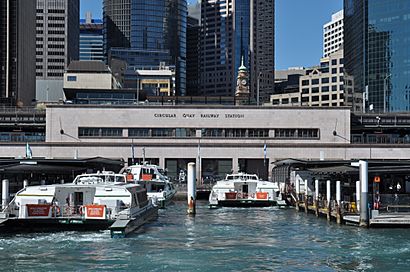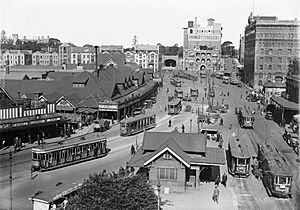Circular Quay railway station facts for kids
Quick facts for kids
Circular Quay
|
|||||||||||||||||||||
|---|---|---|---|---|---|---|---|---|---|---|---|---|---|---|---|---|---|---|---|---|---|

Circular Quay railway station in 2016, looking south from the harbour
|
|||||||||||||||||||||
| Location | Alfred Street, Sydney CBD, New South Wales, Australia |
||||||||||||||||||||
| Coordinates | 33°51′41″S 151°12′40″E / 33.8614°S 151.211°E | ||||||||||||||||||||
| Owned by | Transport Asset Holding Entity | ||||||||||||||||||||
| Operated by | Sydney Trains | ||||||||||||||||||||
| Line(s) | City Circle | ||||||||||||||||||||
| Distance | 2.6 km from Central | ||||||||||||||||||||
| Platforms | 2 side | ||||||||||||||||||||
| Tracks | 2 | ||||||||||||||||||||
| Connections | |||||||||||||||||||||
| Construction | |||||||||||||||||||||
| Structure type | Elevated | ||||||||||||||||||||
| Disabled access | Yes | ||||||||||||||||||||
| Architect | John Bradfield (designer) | ||||||||||||||||||||
| Architectural style | Inter-War Functionalist | ||||||||||||||||||||
| Other information | |||||||||||||||||||||
| Status | Staffed | ||||||||||||||||||||
| Station code | CQY | ||||||||||||||||||||
| History | |||||||||||||||||||||
| Opened | 20 January 1956 | ||||||||||||||||||||
| Electrified | Yes | ||||||||||||||||||||
| Traffic | |||||||||||||||||||||
| Passengers (2018) | 51,820 (daily) (Sydney Trains, NSW TrainLink) | ||||||||||||||||||||
| Rank | 9 | ||||||||||||||||||||
| Services | |||||||||||||||||||||
|
|||||||||||||||||||||
|
|||||||||||||||||||||
Circular Quay railway station is an important train station in Sydney, Australia. It is located in the Circular Quay area, which is a busy transport hub. The station is part of the City Circle train line. It serves trains like the T2 Inner West & Leppington, T3 Bankstown, and T8 Airport & South lines.
Contents
History of Circular Quay Station
Circular Quay has always been a very important place for Sydney. It was once the main harbour for ships coming into the city. Later, it became a busy spot for ferries and trams. This made it a perfect place for a train station too.
Plans for the station started way back in 1909. Tunnels connecting to nearby stations like Central, St James, and Wynyard were built first. Construction of the station itself began in 1936.
Work was stopped for a while because of World War II. It started again in 1945 but was paused again later. The raised train tracks, called a viaduct, were finally finished in 1954. The metal beams used for the viaduct were even used on another bridge first, the Hawkesbury River Railway Bridge, before coming to Circular Quay!
The station building was designed in 1927 and updated in 1937. Finally, Circular Quay station opened on January 20, 1956. The first regular trains started running two days later. This station was the last part of the City Circle train line to be completed.
Building the station in such a famous spot was a big discussion. Some people thought it would block the beautiful views of Circular Quay. When the Cahill Expressway opened above the station in 1958, the debate grew even stronger. There have been ideas to move the station underground, but this has not happened.
In 2006, the station's outside walls were cleaned and repaired. In 2007, new sun shades were added to the platforms. Advertising signs were removed, and the main hall was improved.
Station Design
Circular Quay station has two levels. The main hall, called the concourse, is on the ground floor. The train platforms are on the second, elevated level. From the platforms, you can see amazing views of Circular Quay, the Sydney Harbour Bridge, and the Sydney Opera House. On the other side, you can see Customs House.
The station has two main outside walls. One faces Circular Quay and the other faces Customs House. The northern wall is covered with shiny granite tiles. The southern wall has granite and sandstone. The station's name is written in steel letters on both sides.
The upper part of the station has open areas with glass railings. These offer great views. You can even get to a viewing platform above the station, next to the Cahill Expressway.
To get to the platforms from the ground floor, you can use stairs, escalators, or lifts. The main hall has shops and food places. You can also find public toilets there. The hall has cool brass decorations with sea animal designs. Many parts of the station use glass bricks.
The station's design is called "Inter-War Functionalist." This means it focuses on being useful and has strong straight lines. It also has some "Art Deco" details, which are decorative patterns from the 1920s and 1930s.
Trains and Services
| Platform | Line | Stopping pattern | Notes |
| 1 |
2
|
services to Homebush, Parramatta, Leppington | |
|---|---|---|---|
| 2 |
8
|
services to Revesby & Macarthur 2 weekday evening services to Campbelltown |
|
|
3
|
services to Lidcombe & Liverpool via Bankstown |
Circular Quay station has two platforms.
- Platform 1 is for trains heading towards places like Homebush, Parramatta, and Leppington (T2 line).
- Platform 2 is for trains going to Revesby and Macarthur (T8 line), or Lidcombe and Liverpool via Bankstown (T3 line).
Getting Around (Transport Links)
Circular Quay is a major transport hub.
- Buses: South of the station, there's a bus stop on Alfred Street. Many bus routes start from here.
- Ferries: Right next to the station is Circular Quay wharf. You can catch ferries here to many different parts of Sydney Harbour.
Gallery
Images for kids








